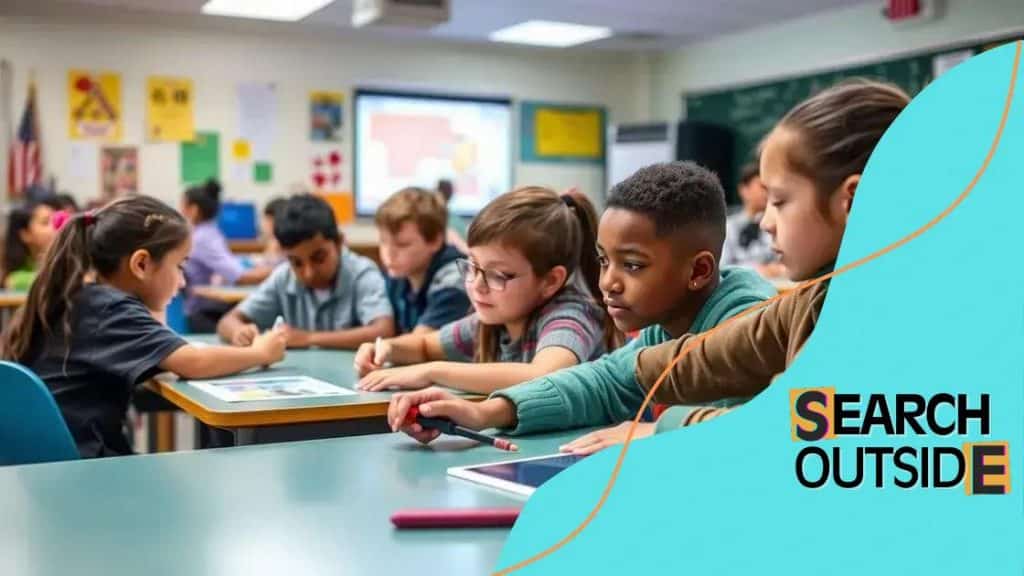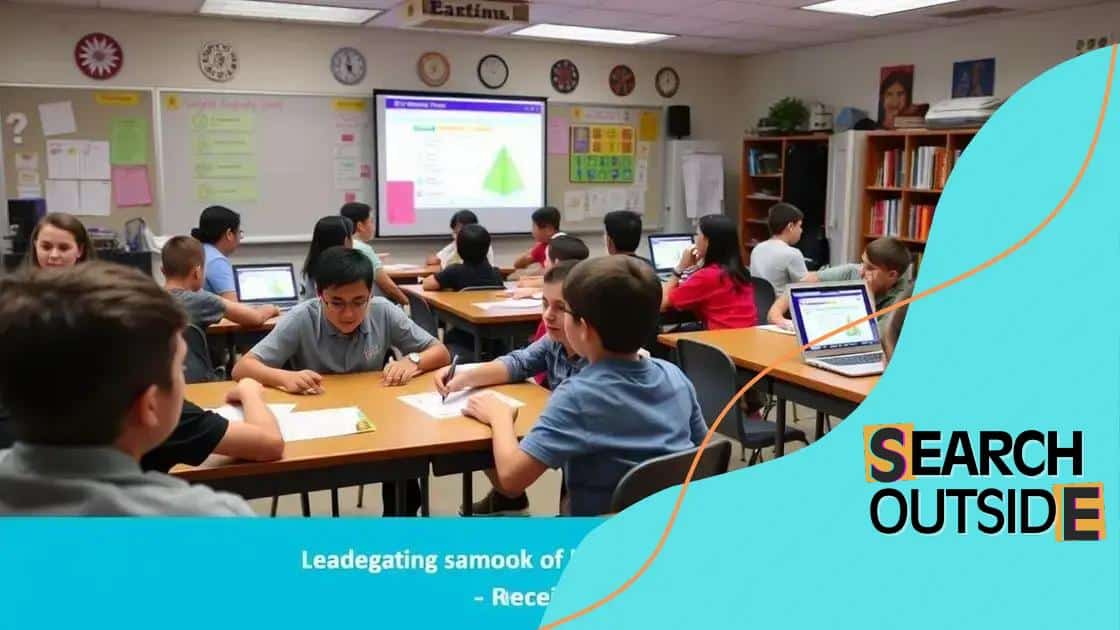The role of gamification in increasing student engagement

The role of gamification in increasing student engagement is crucial, as it utilizes game elements to enhance motivation, participation, and learning experiences in educational settings.
The role of gamification in increasing student engagement is becoming increasingly important in educational settings. Have you ever wondered how turning learning into a game can spark excitement in students? Let’s dive into the benefits and applications of this approach.
Understanding gamification and its principles
Understanding gamification is essential for enhancing student engagement in educational environments. It involves incorporating game-like elements into learning processes to motivate students and make learning more enjoyable.
At its core, gamification leverages the same principles that make games captivating. For instance, it introduces challenges, achievements, and points systems that encourage participation. Think about how rewarding it feels to complete a level in a game; similar concepts can be applied to classroom activities.
Key principles of gamification
There are several important principles that underline successful gamification:
- Choice: Providing students with choices in their learning fosters ownership and motivation.
- Immediate feedback: Instant feedback boosts engagement and helps students understand their progress.
- Progression: A clear progression path keeps students motivated and encourages continuous effort.
- Collaboration: Encouraging teamwork can build a sense of community and enhance learning experiences.
Another crucial aspect of gamification involves setting achievable goals and measurable outcomes. When students see their progress through a points system or levels, they’re more likely to stay engaged. Incorporating leaderboards can also increase motivation by tapping into friendly competition.
In addition, gamification can make complex subjects more approachable. When students face challenges in a game-like scenario, they view learning as a fun activity rather than a chore. This transformation in mindset is vital for encouraging persistence and resilience in learners.
Furthermore, gamification tailors learning experiences to diverse student needs. By offering various pathways to achieve the same learning goals, it accommodates different learning styles and paces.
Benefits of gamification in education
The benefits of gamification in education are numerous and impactful. By transforming traditional learning methods, it fosters an engaging environment. Students are more likely to participate and enjoy lessons when game-like elements are involved.
One significant advantage is improved student motivation. When students play games, they strive for achievements. Gamification applies this same drive to academic tasks, encouraging learners to take part actively.
Key benefits of gamification
Here are some of the key benefits that gamification brings to education:
- Enhanced engagement: Interactive elements attract students’ attention, making them more involved in their learning.
- Better retention: Gamified experiences often lead to improved memory of the material learned.
- Encouragement of collaboration: Many gamified activities involve teamwork, which builds crucial social skills.
- Immediate feedback: Students receive prompt responses about their performance, allowing them to adjust their strategies quickly.
Moreover, gamification can cater to different learning styles. It provides various approaches to problem-solving, making it suitable for visual, auditory, and kinesthetic learners. This flexibility helps all students find a way to succeed.
Gamified assessments also lower students’ anxiety. When they view tests and quizzes as games, they are less likely to feel pressured. Consequently, students can showcase their knowledge better.
Overall, gamification is not just about adding fun but enriching the learning experience. It creates a more dynamic classroom environment, stimulating curiosity and a love for learning.
Examples of gamification in the classroom

Examples of gamification in the classroom showcase how this method enhances learning. Teachers around the world creatively apply game elements to engage students and boost participation.
One popular example is using points systems. Teachers can assign points for completing assignments, participating in discussions, or helping peers. As students earn points, they can unlock rewards, creating excitement.
Real-world examples of gamification
Here are some real-world examples of how gamification can be implemented in educational settings:
- Classroom leaderboards: Displaying a leaderboard encourages friendly competition among students. It motivates them to improve their performance to reach the top.
- Digital badges: Award badges for achieving specific goals or mastering skills. Students enjoy collecting badges, creating a sense of accomplishment.
- Interactive quizzes: Use quiz apps that turn tests into games. Platforms like Kahoot! or Quizizz engage students with fun, game-like assessments.
- Story-based learning: Creating narratives where students are characters on a quest can help them immerse themselves in the subject. This approach relates coursework to exciting storylines.
In addition, teachers can implement challenges where students team up to solve problems. This fosters collaboration and helps them feel part of a community. When working together, they build skills beyond academics.
Furthermore, gamification can make complex subjects more understandable by breaking them into manageable tasks. Students can progress through levels, mastering each before moving on. This gradual approach helps reduce anxiety and encourages persistence.
Challenges of implementing gamification
Implementing gamification in education comes with its own set of challenges. While the benefits are clear, obstacles can hinder successful adoption. Understanding these challenges can help educators navigate them more effectively.
One of the primary challenges is resistance to change. Some educators may be skeptical about adopting new methods, preferring traditional teaching methods that they are comfortable with. Overcoming this reluctance requires clear communication about the benefits of gamification.
Common challenges faced
Here are some common challenges educators encounter when implementing gamification:
- Resource limitations: Not all schools have access to technology or resources needed for gamified activities. This can restrict how effectively gamification can be applied.
- Training needs: Educators may require training to implement gamification strategies effectively. Without proper training, teachers may feel overwhelmed or unsure about how to integrate game elements.
- Difficulty in measuring results: Measuring the effectiveness of gamification can be challenging. Educators must find appropriate metrics to assess student engagement and learning outcomes.
- Balance between fun and education: It’s important to ensure that gamification does not overshadow educational content. Finding the right balance can be tricky.
Additionally, students may have varying reactions to gamified lessons. Some may thrive in a game-like environment, while others may feel distracted or less engaged. Individual preferences and learning styles should be taken into account when designing these activities.
Finally, ongoing maintenance is another challenge. Once gamification strategies are in place, educators must continually update and adjust them to keep students engaged. This requires time and effort, which can be hard to manage alongside regular teaching duties.
Future trends in gamification for education
Future trends in gamification for education are exciting and full of potential. As technology advances, new methods will emerge to engage students and enhance learning. Staying informed about these trends can help educators maximize their impact.
One significant trend is the increased use of virtual reality (VR) and augmented reality (AR). These technologies create immersive experiences that can transport students to different worlds, making learning more interactive. For example, students might explore ancient civilizations through a VR simulation, enhancing their understanding of history.
Emerging trends in gamification
Several key trends are expected to shape the future of gamification in educational settings:
- Personalized learning: As AI technology evolves, educators can create customized gamified experiences that adapt to each student’s learning pace and style.
- Collaboration tools: Online platforms will increasingly enable students to work together on gamified projects, fostering teamwork and communication skills.
- Integration of AI: AI will play a role in analyzing student performance and adjusting challenges to meet their needs, ensuring deeper engagement.
- Gamification in remote learning: As online education becomes more popular, gamification will be crucial for maintaining student interest and encouraging participation.
Moreover, the gamification of assessment is likely to evolve. Traditional tests may shift toward game-like evaluations, where students demonstrate skills through interactive scenarios rather than static questions. This innovative approach can offer a more comprehensive understanding of student learning.
Additionally, as educators recognize the benefits of social-emotional learning, gamification techniques may include elements that promote empathy, resilience, and collaboration. This focus on the whole student ensures that learning isn’t just about academics but also personal growth.
FAQ – Frequently Asked Questions about Gamification in Education
What is gamification in education?
Gamification in education refers to incorporating game elements in learning activities to enhance student engagement and motivation.
What are the benefits of using gamification in the classroom?
Gamification can increase student motivation, improve engagement, enhance retention of information, and foster teamwork skills.
How can technology be used in gamification?
Technology such as virtual reality (VR) and online platforms can create immersive learning experiences that engage students more effectively.
What challenges might educators face when implementing gamification?
Common challenges include resistance to change, resource limitations, and the difficulty of measuring the effectiveness of gamified activities.





